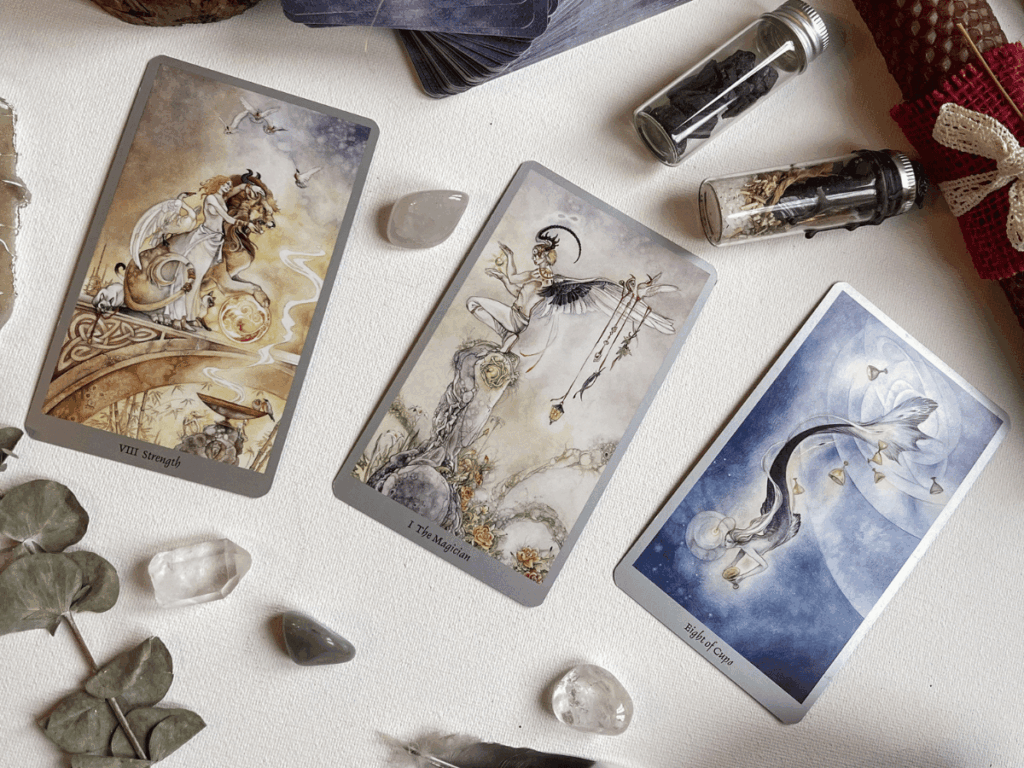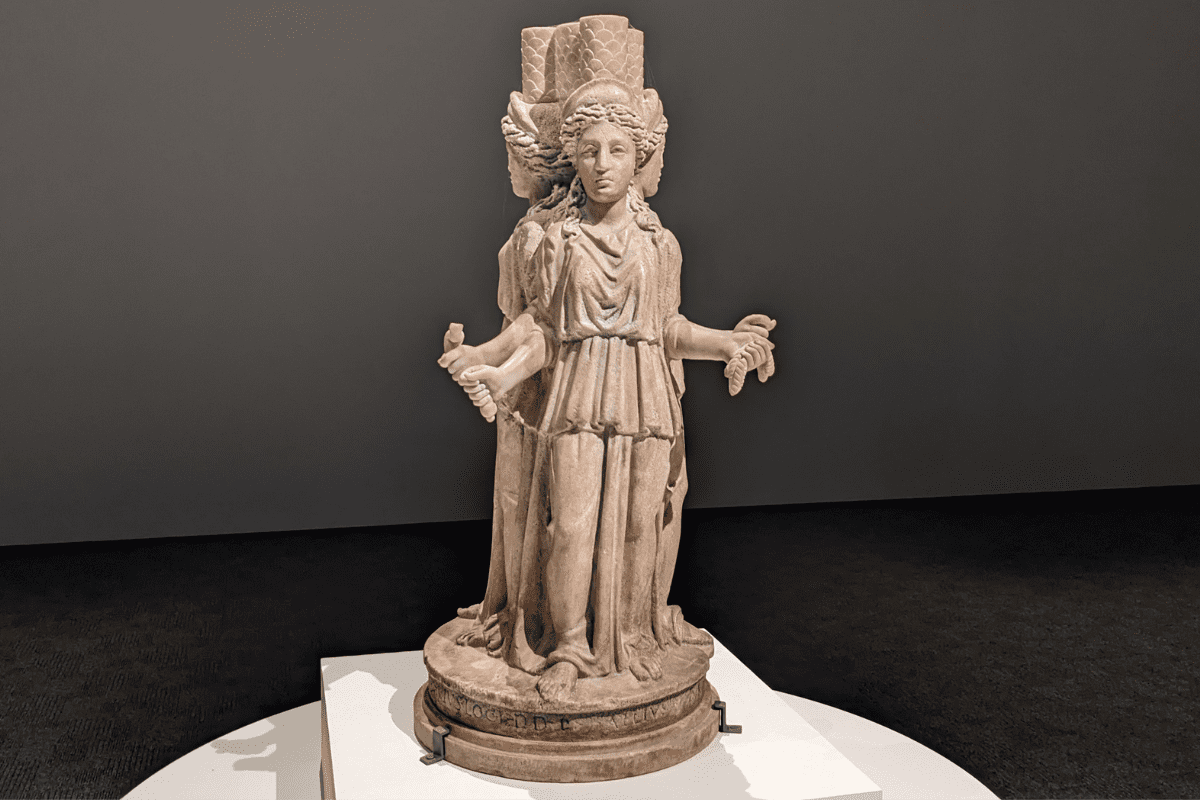Stand at a crossroads at dusk and listen. Somewhere between the dog’s bark and the hush of wind through eucalypts is a presence that steadies the nerves and sharpens the senses. That’s Hekate, the guardian of thresholds, torch-bearer in the dark, patron of witches.
This starter guide offers mythic context, correspondences, altar inspiration, devotional rhythms, acts of service, and tools to help you build a grounded relationship with Hekate in contemporary life. I hope you find pathways here to connect with the goddess who lights the way through darkness.
Who is Hekate?
In Greek tradition, Hekate is a Titaness who moves freely between worlds—earth, sea, and sky; the living, the dead, and the divine. She is the keeper of keys, the bringer of light in darkness, the protector at doorways and city gates, and a formidable ally in magic. Ancient hymns praise her as Kourotrophos (nurturer of the young), Soteira (saviour), Kleidoukhos (key-holder), Brimo (the terrifying one), and Apotropaia (turner away of evil). Later images show her as trimorphis, three-formed, watching all directions at once.
For modern practitioners, Hekate arrives with practical gifts: the discernment to see clearly at life’s crossroads, the courage to meet what we’ve kept in shadow, the ability to hold firm boundaries, and a steady lantern for whatever comes next. She helps us end what needs ending and begin what needs beginning. She offers protection that has teeth, banishing that severs cleanly, and when necessary, the magic of just consequences.
Like most ancient deities, Hekate’s nature encompasses apparent opposites: she protects and destroys, nurtures and terrifies, illuminates and conceals. In ancient practice, she was invoked for protection, banishing, binding, and justice work. As psychopomp (guide of souls), she helps the dead reach the underworld and protects the living from harmful spirits. Many are drawn to Hekate for her associations with magic, the dead, and fierce protection. These aspects of her practice require clear ethics, good discernment, and time to develop the relationship. For those interested in deeper exploration of working with Hekate in protection magic, justice work, and practices involving the dead, I’ll address these topics in future dedicated posts.
For a deeper exploration of Hekate’s mythology, historical worship, and various ways people have understood her across time and traditions, see my other blogs about Hekate.
Correspondences
Ancient correspondences
These correspondences are rooted in historical worship and ancient sources:
- Sacred animals: Dog, snake, horse, polecat/weasel
- Sacred plants: Garlic, onion, leeks, yew, bay/laurel, cypress
- Traditional symbols: Keys, torches, crossroads, daggers/knives, rope/cord
- Traditional offerings: Garlic, onions, eggs, bread, honey cakes, wine or milk, fish (especially red mullet), storax incense
- Colours: Saffron
Modern correspondences
These modern associations enhance contemporary practice but aren’t historically attested. Work with correspondences through direct interaction: burn incense, hold crystals during meditation, wear Hekate’s colours, keep images on your altar.
- Colours: Black, deep indigo, wine-red, bone white, bronze-gold
- Crystals: Obsidian, jet, moonstone, smoky quartz, labradorite, haematite
- Incense: Myrrh, frankincense, cypress, bay, rosemary
- Symbols: Strophalos/Hekate’s Wheel, broom, cauldron, owl, spider
- Plants: Dandelion, mugwort, pomegranate
Altar inspiration
An altar for Hekate can be elaborate or simple. Let your space reflect the clarity and purpose she embodies.
- Colour story: Matte black base (velvet, charcoal, deep shadow) with bone-white accents and a glint of metal—a key or candle-snuffer
- Core setup: Black candle (or battery tea light), small lantern or torch image, a key, bowl or jar for offerings, image of Hekate and the crossroads
- Small-space option: Travel tin with key charm, tea light, image of Hekate
- Outdoor offerings: Choose unobtrusive spots, use only biodegradable offerings, remove all packaging, and never leave anything that could harm wildlife.
Sacred timing
Hekate’s Deipnon (Dark Moon): The night before the New Moon, a time to cleanse, release, and leave offerings
Noumenia (New Moon): Begin the month with fresh intentions and a rekindled lamp
Other times: Last day of each month, liminal hours (dusk, dawn), crossroads moments in your life
Making it work for you
Deep work doesn’t require expensive tools or perfect conditions. Keep your practice simple, safe, and kind.
- Keep it simple: Use battery tea lights, old keys, or chalk crossroads.
- Cost-conscious: Borrow books, shop second-hand, make kitchen offerings, draw a crossroad on recycled paper.
- Safety first: Use stable holders, never leave a flame unattended, ensure proper ventilation, and be mindful of allergies.
- On connection: If you don’t feel a connection with Hekate initially, that’s completely normal. Deity relationships can develop slowly, and not every deity resonates with every person. Trust your own pace and experience.
The Deipnon and Noumenia
The Deipnon and Noumenia were two separate, but related events in the ancient worship of Hekate and other gods. Modern practitioners commonly combine them and perform them during the new moon. It is one of the most enduring practices in her worship, a time to release and close the lunar cycle and begin anew.
Traditionally, Deipnon offerings feed both Hekate and the restless dead—spirits of those who died violently, far from home, or without proper burial rites. This acknowledges Hekate’s dual role: protecting the living from harmful spirits while leading and caring for those who wander.
For more guidance, see my blog entry on observing the Deipnon and Noumenia.
Seven-day devotional practice
A simple weekly cycle to deepen your relationship with Hekate.
Day 1 – Threshold: Sweep your entry. Place a key on your altar: ‘Hekate Propylaia, bless this threshold and all who cross it in good faith.’
Day 2 – Lantern: Light a candle; meditate 9 minutes on your next right step. Journal one action.
Day 3 – Cleansing: Smoke-cleanse or sound-cleanse your space; dispose of sweepings respectfully.
Day 4 – Divination: Pull three cards (see ‘Tarot touchpoints’ below). Note boundaries, choices, and allies.
Day 5 – Service: Do one protective, practical act (see below).
Day 6 – Study & craft: Read the Orphic Hymn to Hekate, learn about one sacred plant safely, or practise knot magic for protection.
Day 7 – Rest & integration: Sit at dusk. Hold a key and breathe with the threshold between day and night.
Deipnon preparation: Near a dark moon, tidy altars, clear offerings, and prepare a small plate (bread, eggs, garlic) for Hekate.
Tarot touchpoints
In my experience, Hekate speaks through: The High Priestess (liminal knowing), The Moon (shadow navigation), Death (necessary endings), The Hermit (lantern wisdom), Justice (right proportion).

Here’s a simple three-card spread:
- The road behind: what to close
- The gate I’m at: what’s true now
- The torch ahead: next right step
Journalling prompts
Use these prompts to translate devotion into personal insight, or draw tarot cards in response to each question for additional guidance.
- Which threshold am I guarding or avoiding right now?
- Where do I need clearer, kinder boundaries
- What wants to end with integrity so something truer can begin?
- What fear dissolves when I bring a little light and companionship?
- What key am I ready to claim (skill, responsibility, role)?
Acts of service
Hekate inspires action alongside devotion. Here are some ways to serve, organised around her major themes:
Protection and way-finding: Support threshold services such as youth shelters, domestic violence services, refugee aid, and LGBTIQ+ organisations.
Animal welfare: Support dog rescues, carry spare leads, report strays safely, support wildlife care for nocturnal animals, and volunteer at animal shelters.
Caretaking the in-between: Tend neglected threshold spaces (laneways, footpaths, cemetery edges), pick up rubbish in liminal zones, improve safety in transitional spaces (report broken lights, clear overgrown paths where appropriate), and maintain community resources such as little free libraries or noticeboards.
Cultural sensitivity
Hekate’s worship has travelled widely, and that adaptability is part of her gift. As you develop practice, honour living traditions by learning respectfully and avoiding appropriation.
Consider whether public offerings are appropriate or whether work-at-home thresholds are more appropriate. Use only biodegradable, wildlife-safe offerings. Never leave anything harmful to native animals. Be aware of council bylaws. Be a good neighbour: don’t disturb residents and leave spaces clean. Create crossroads symbols at home, work at your front threshold, or visualise crossroads in meditation. Hekate honours intention over public display.
Hekate in daily life
You might recognise Hekate’s presence as sudden clarity about decisions after weeks of fog, dogs taking unusual interest in your rites, repeating key/door/lock motifs (a lost key found, a door that won’t close), desire to tidy thresholds or end things cleanly, steadier relationship with darkness (night walks, new moon rhythms, shadow work), increased boundary awareness, or vivid dreams featuring crossroads, keys, or torches.
Living at the crossroads
In times of transition and uncertainty, Hekate’s presence feels both steadying and clarifying—a reminder that thresholds are places of power, not just passages. Working with her may involve literal crossroads or the everyday magic of knowing when to open doors and when to lock them, when to light the way forward and when to rest in the dark.
Start small: a swept step, a lit lamp, a key held with intention. Hekate meets us where paths cross when we’re ready to end well, begin wisely, and keep walking with a faithful light. She doesn’t ask for perfection, but for presence: the willingness to stand at thresholds with clear eyes, to hold the lantern steady, and to choose the next right step.
The crossroads are everywhere. In every decision, every boundary, every moment of transition, Hekate stands ready, not to choose for us, but to light the way so we can see clearly enough to choose for ourselves. In honouring Hekate, we learn to trust our own discernment, to move through darkness without fear, and to recognise that every threshold is an invitation to step into the next true thing.

